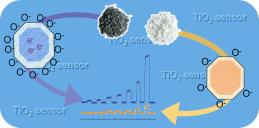[1] Chen, X.; Mao, S. S. Chem. Rev. 2007, 107, 2891.

[2] (a) Wu, N.; Wang, J.; Tafen, D. N.; Wang, H.; Zheng, J.; Lewis, J. P.;Liu, X.; Leonard, S. S.; Manivannan, A. J. Am. Chem. Soc. 2010,132, 6679; (b) Kang, S. H.; Choi, S.; Kang, M.; Kim, J.; Kim, H.;Hyeon, T.; Sung, Y. Adv. Mater. 2008, 20, 54; (c) Zou, X.-X.; Li,G.-D.; Wang, Y.-N.; Zhao, J.; Yan, C.; Guo, M.-Y.; Li, L.; Chen, J.-S.Chem. Commun. 2011, 47, 1066; (d) Chen, X.; Liu, L.; Yu, P. Y.;Mao, S. S. Science 2011, 331, 746.

[3] Valentin, C. D.; Pacchioni, G.; Selloni, A. J. Phys. Chem. C 2009,113, 20543.

[4] Livraghi, S.; Maurelli, S.; Paganini, M. C.; Chiesa, M.; Giamello, E.Angew. Chem. Int. Ed. 2011, 123, 8188.

[5] Khomenko, V. M.; Langer, K.; Rager, H.; Fett, A. Phys. Chem.Minerals 1998, 25, 338.

[6] He, Y.; Dulub, O.; Cheng, Y.; Selloni, A.; Diebold, U. Phys. Rev.Lett. 2009, 102, 106105.

[7] Zou, X.-X.; Li, G.-D.; Wang, K.-X.; Li, L.; Su, J.; Chen, J.-S. Chem.Commun. 2010, 46, 2112.

[8] Zhao, Q.; Wu, P.; Li, B. L.; Lu, Z. M.; Jiang, E. Y. J. Appl. Phys.2008, 104, 073911.
[9] Li, M.; Hebenstreit, W.; Diebold, U.; Tyryshkin, A. M.; Bowman, M.K.; Dunham, G. G.; Henderson, M. A. J. Phys. Chem. B 2000, 104,4944.

[10] Yagi, E.; Hasiguti, R. R.; Aono, M. Phys. Rev. B 1996, 54, 7945.

[11] Nakamura, I.; Negishi, N.; Kutsuna, S.; Ihara, T.; Sugihara, S.Takeuchi, K. J. Mol. Catal. A 2000, 161, 205.

[12] Liu, G.; Yang, H. G.; Wang, X.; Cheng, L.; Lu, H.; Wang, L.; Lu, G.Q.; Cheng, H.-M. J. Phys. Chem. C 2009, 113, 21784.

[13] Zuo, F.; Wang, L.; Wu, T.; Zhang, Z.; Borchardt, D.; Feng, P. J. Am.Chem. Soc. 2010, 132, 11856.

[14] Franke, M. E.; Koplin, T. G.; Simon, U. Small 2006, 2, 36.

[15] Lira, E.; Wendt, S.; Huo, P.; Hansen, J. ø.; Streber, R.; Porsgaard,S.; Wei, Y.; Bechstein, R.; L?gsgaard, E.; Besenbacher, F. J. Am.Chem. Soc. 2011, 133, 6529.

[16] Qian, L.; Jin, Z. S.; Zhang, J. W.; Huang, Y. B.; Zhang, Z. J.; Du, Z.L. Appl. Phys. A 2005, 80, 1801.

[17] Dimitrijevic, N. M.; Saponjic, Z. V.; Rabatic, B. M.; Poluektov, O.G.; Rajh, T. J. Phys. Chem. C 2007, 111, 14597.

[18] (a) Garzella, C.; Comini, E.; Tempesti, E.; Frigeri, C.; Sberveglieri,G. Sens. Actuators B 2000, 68, 189; (b) Garzella, C.; Bontempi, E.;Depero, L. E.; Vomiero, A.; Mea, G. D.; Sberveglieri, G. Sens.Actuators B 2003, 93, 495; (c) Benkstein, K. D.; Semancik, S. Sens.Actuators B 2006, 113, 445.

[19] (a) Jing, Z.; Zhan, J. Adv. Mater. 2008, 20, 4547; (b) Chen, D.; Hou,X.; Wen, H.; Wang, Y.; Wang, H.; Li, X.; Zhang, R.; Lu, H.; Xu, H.;Guan, S.; Sun, J.; Gao, L. Nanotechnology 2010, 21, 035501; (c)Kim, S.-J.; Hwang, I.-S.; Na, C. W.; Kim, I.-D.; Kang, Y. C.; Lee,J.-H. J. Mater. Chem. 2011, 21, 18560.

[20] (a) Yamaura, H.; Tamaki, J.; Moriya, K.; Miura, N.; Yamazoe, N. J.Electrochem. Soc. 1997, 144, L158; (b) Yamaura, H.; Jinkawa, T.;Tamaki, J.; Moriya, K.; Miura, N.; Yamazoe, N. Sens. Actuators B1996, 35-36, 325; (c) Sedghi, S. M.; Mortazavi, Y.; Khodadadi, A.Sens. Actuators B 2010, 145, 7; (d) Yu, J. H.; Choi, G. M. Sens.Actuators B 2001, 75, 56; (e) Moon, W. J.; Yu, J. H.; Choi, G. M.Sens. Actuators B 2001, 80, 21.

[21] (a) Kocemba, I.; Rynkowski, J. Sens. Actuators B 2011, 155, 659;(b) Saukko, S.; Lassi, U.; Lantto, V.; Kroneld, M.; Novikov, S.;Kuivalainen, P.; Rantala, T. T.; Mizsei, J. Thin Solid Films 2005,490, 48.

[22] Zou, X.-X.; Li, G.-D.; Guo, M.-Y.; Li, X.-H.; Liu, D.-P.; Su, J.;Chen, J.-S. Chem.-Eur. J. 2008, 14, 11123.
[23] Zou, X.-X.; Li, G.-D.; Zhao, J.; Wang, P.-P.; Wang, Y.-N.; Zhou,L.-J.; Su, J.; Li, L.; Chen, J.-S. Inorg. Chem. 2011, 50, 9106.






















